
“Doctor shopping” is a term that refers to the behavior of a person who visits multiple physicians in an attempt to obtain prescriptions for controlled substances, such as opioids. The person may then abuse, sell, or distribute these drugs unlawfully. This practice is illegal, and those who engage in it face significant risks, including legal penalties, addiction, and overdose.
People who doctor shop attempt to deceive physicians into believing they need medication for legitimate purposes and do not disclose that they are also filling prescriptions from other doctors. Also, some physicians may be aware that a patient is doctor shopping but, despite this fact, write the requested prescriptions for profit.
Of all pharmaceutical drugs, opioids are the #1 target for doctor shoppers. In 2008, one in 143 patients in the U.S. received an opioid prescription from more than one physician, a pattern that is highly suggestive of doctor shopping behavior. And, while doctor shoppers made up only 0.7% of all American patients who received an opioid prescription that year, they purchased 2% of all opioid prescriptions and 4% of the total amount of pharmaceutical opioids as measured by weight.
A recent study by the Centers for Disease Control and Prevention (CDC) examined unintentional prescription-drug overdose deaths and revealed that 21.4% of the deceased had engaged in doctor shopping prior to their death. Doctor shopping is almost always evidence of illicit distribution or prescription drug abuse, especially where opioids are concerned. It remains one of the major factors driving the opioid and heroin addiction crisis in the U.S. today.
This practice is illegal in all 50 states and Washington D.C., and many state laws enforce severe criminal penalties that can result in lifelong consequences for offenders. Additionally, almost every state has implemented a prescription drug monitoring program as a means to track patients who receive opioid prescriptions.
Who Engages in Doctor Shopping?
People who are seeking opioids are the most common among doctor shoppers. A 2013 study examined opioid prescription histories to identify doctor shoppers by their purchasing patterns. After analyzing a dataset of over 146 million opioid prescriptions dispensed by 76% of pharmacies in the U.S., researchers identified what they referred to as an “extreme group” of around 135,000 suspected doctor shoppers.
On average, this group filled 32 prescriptions for opioids from 10 different physicians over a 10-month period, and most of these likely doctor shoppers were between 26-35 years of age. Overall, this extreme group received 11.1 million grams of opioids over the 10-month period—that is equivalent to 109 milligrams of morphine per patient day for an entire year.
Of note, the risk of overdose is high for people who use 100 milligrams of morphine per day. In a national sample of Veterans Health Administration patients with chronic pain who received opioids from 2004–2009, patients who had died of opioid overdose were prescribed an average of 98 MME (morphine milligram equivalents) per day, while other patients were prescribed an average of just 48 MME per day.
A 2014 study by the University of North Carolina and Georgia Southern University sought to shed light on physician deception by examining its prevalence, motivations, and risk factors. In a random sample of more than 2,300 young adults, 4% reported they had attempted to deceive a physician in order to obtain a pharmaceutical drug.
About 50% of those who admitted to deceiving a doctor said their motivation was to sell some of the prescription medication. Although, most of these individuals also reported that their own propensity toward substance abuse at least partly drove their behavior.
There are actually several reasons why patients could engage in doctor shopping. Some reason may be related to mental health disorders (e.g., substance abuse and addiction), while others may be linked to the persistence of symptoms or dissatisfaction with the first doctor or his/her medical opinion. While the nature of these psychological disorders is varied, the majority of doctor shopping incidents appears to be directly related to substance abuse.
Drugs That Doctor Shoppers Target

The U.S. Drug Enforcement Administration (DEA) has identified five drug classes that are common targets for doctor shopping and other types of drug diversion: opioids, benzodiazepines, stimulants, anabolic steroids, and weight-loss drugs.
A study from 2010 published in the journal Drug and Alcohol Dependence examined the most extensive electronic prescription drug monitoring program in the U.S. and found that opioids were the most commonly sought after among doctor-shopping patients. Indeed, opioids accounted for nearly 13% of all prescriptions involved in multiple provider events. Benzodiazepines were next at 4.2%, followed by stimulants at 1.4% and weight-loss medications at 0.9%.
Doctor Shopping Prevention Methods
While it can be challenging for health care professionals to identify instances of doctor shopping, there are a few steps that can be taken to minimize or prevent it. State drug monitoring programs that track prescriptions help doctors and pharmacists recognize possible cases of doctor shopping and other types of drug diversion.
And, as noted, all 50 states and Washington D.C. have enacted laws that outlaw doctor shopping in some fashion. Each state has a fraud statute that makes it illegal to obtain (or even attempt to obtain) a narcotic by fraud or misrepresentation.
Prescription Drug Monitoring Programs
Prescription drug monitoring programs (PDMPs) require physicians and pharmacists to record each prescription medication filled in a government database. This allows health care providers to identify people who may be engaging in doctor-shopping behaviors.
As of the time of this writing, every state except Missouri has an operational PDMP in place. Several credible studies have found that PDMPs are an effective means for discouraging doctor-shopping behavior and reducing the prevalence of doctor shopping.
Pharmacists
Pharmacists hold a significant amount of responsibility in preventing doctor shoppers from obtaining controlled substances. By watching for fraudulent or altered prescriptions and patients with multiple prescriptions from more than one physician, pharmacists are uniquely positioned and qualified to identify individuals who may be doctor shopping. Also, many pharmacies have hotlines to notify other pharmacies in the area when a falsified prescription has been detected.

Getting Treatment for Addiction
Doctor shopping behavior is frequently an indication of a substance use disorder. People who engage in these practices may be physically addicted to prescription drugs, and professional substance abuse treatment may be the only way to help those who are suffering.
Midwood Addiction Treatment offers a comprehensive approach to substance abuse treatment and includes both partial-hospitalization and intensive outpatient formats. We employ evidence-based services essential to the process of recovery, including the following:
Our professional addiction specialists facilitate these services to clients with care and expertise. We are dedicated to providing each patient with the resources, tools, and support they so desperately need to achieve abstinence and enjoy long-term wellness and sobriety.
If you or someone you know has been defrauding health care providers in an effort to obtain a controlled substance, please seek treatment as soon as possible.
Call us today to discuss treatment options. Discover how we help people free themselves from the grips of addiction so they can experience the happy and fulfilling lives they deserve!